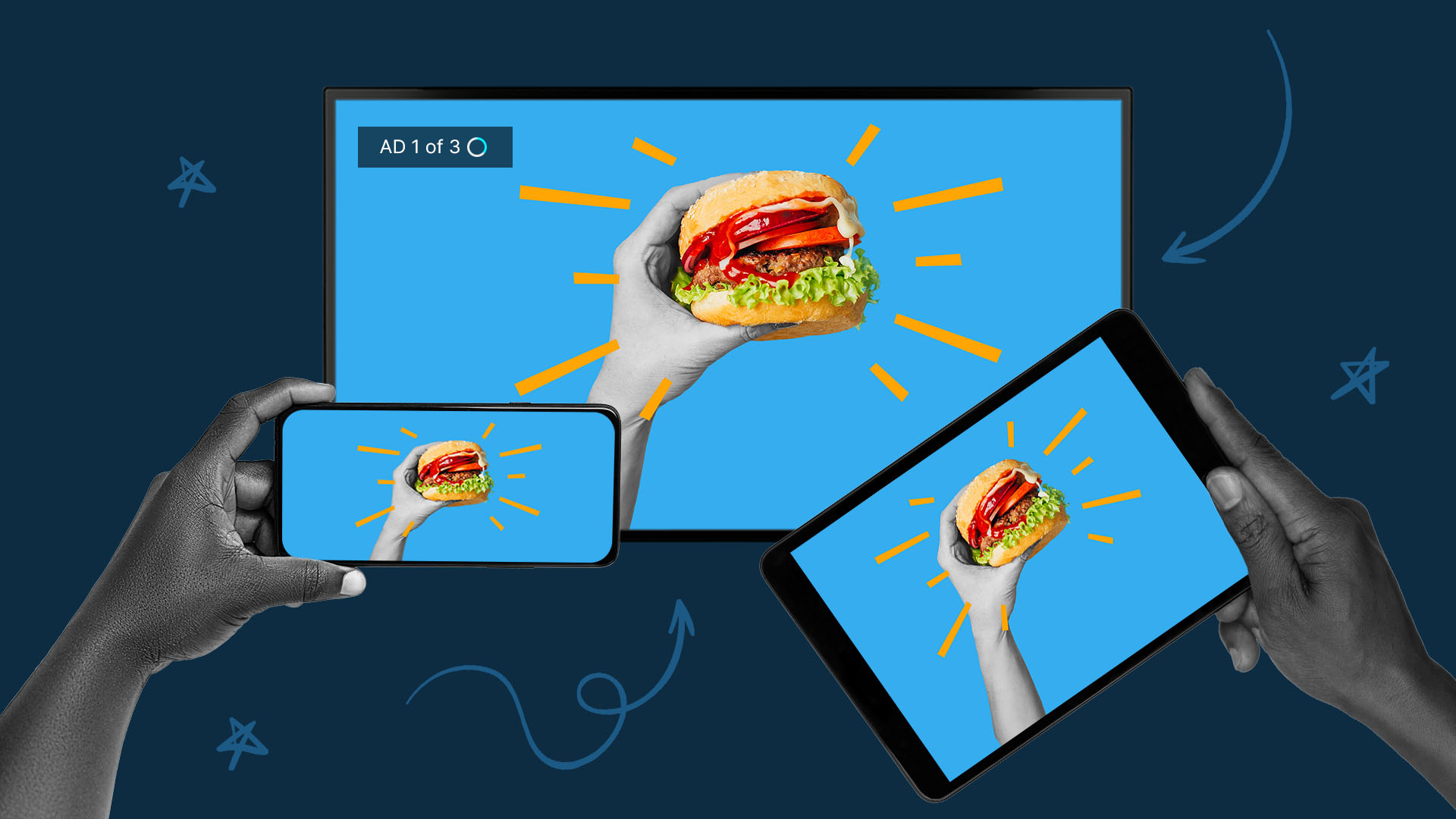The ABCs of Targeting: Audience-Based Conversations

As marketing strategies continue to evolve and teams get more options for effective targeting, platform-specific personalization remains more essential than ever. Why? Because you shouldn’t talk to your audience via Connected TV (CTV) the same way you talk to them on Meta platforms. Even if they’re the same people, context is everything.
But how do you know what the difference is? And how should you approach that in your marketing strategy?
Here, we’ll explore the importance of audience-based conversations and effective targeting in your performance marketing strategy. Plus, we’ll dive into some of the differences between your audiences so you can start crafting platform-specific targeting strategies.
Why Is Precision Targeting Essential?
It might seem obvious: you want to reach your audience. (Duh.)
But there’s a reason we’re asking that question in the first place. And it’s because you haven’t always been able to reach your audience in the ways you wanted. Previously, with traditional platforms like direct mailers and linear TV, there was an element of uncertainty. Sure, we’ve sent the message out — but did anyone see it?
Plus, with evolving data privacy regulations around the world, your marketing team might be more concerned about targeting than ever before. While these laws are long overdue, they’re also changing the way we reach our audiences.
Now, marketing teams need to take these adjustments and challenges into account as they craft their next campaign strategy. The rules of the marketing game may be changing, but we still need to create personalized and purpose-driven experiences for audiences.
When it comes to your performance strategy, you want to know the right people are seeing your ads on the right platforms. And don’t get us wrong — there’s absolutely a time and place for more generalized advertising. It just doesn’t belong in your performance marketing strategy with specific audience targets.
Starting Audience-Based Conversations Across Platforms
There’s a lot to keep up with in the video marketing industry today. Between the seemingly countless platforms, evolving social media ad specs, new features, and so much more, it can feel overwhelming.
Unfortunately, that’s not a good enough reason to create broad video content and hope it sticks on every wall with all of your audience segments (spoiler: it won’t). In order to truly capture your audience’s attention, you have to create platform-specific content that drives interest in your business.
Enter purpose-built creative. This concept is exactly what it sounds like: it’s creative built with a specific purpose — like a goal, objective, or audience segment — in mind. This helps you more easily connect with your audience with specific content that speaks to them directly.
Statistically, as mentioned above, many of the same people are watching your content across several channels. Since US social media users have an average of 7.1 profiles per person, there’s going to be some overlap. And that number gets even higher on a global scale, rising to an average of 8.4 profiles per person.
You don’t want to generate ad fatigue early on by showcasing the same piece of content over and over again — especially if you’re using an omnichannel digital marketing strategy.
Plus, your audience expects something different from brands across different channels, so if they get on Instagram and see the exact same content they just saw on their TV screen, they’re going to be, at best, a little annoyed.
Let’s take a look at how you can reach your audience across different platforms and video marketing formats.
How To Reach Your Audience on Social Media
Social media evolves quickly and frequently, often making it difficult for marketing teams to use it effectively.
Plus, each platform has slight differences that make a significant impact on key performance indicators (KPIs) and other results. And the same goes for user demographics by social platform. While they are similar, they aren’t the same.
This formerly photo-first platform is a great way to connect with your audience. As one of the three main Meta platforms now, it consistently draws a large number of users. Instagram reported they have over 2 billion users on the platform, and there’s no sign of slowing down.
On Instagram, you’ll need to take into account the Instagram video ad specs before getting started. If you share a video that doesn’t feel native to the platform, users are less likely to engage with the content.
You’ll also want to learn about the Instagram algorithm and the best practices you can implement to work with the platform. For example, you’ll need to find the best times to post on Instagram for your business. With an optimized posting schedule, the content will do well initially and then be pushed out by the algorithm to a wider audience.
When it comes to overall Instagram video marketing, you’ll also want to ensure you’re staying up to date with trends. Your audience expects to see platform-specific content, which could include Instagram Reels, Stories, and more.
Overall, when you’re speaking to an audience on Instagram, you’ll want to focus on educating while entertaining. Direct sales tactics aren’t usually the best strategy on Instagram (or social media in general), so you’ll want to take advantage of this time to teach your audience about your brand, showcase your products, or create a genuine connection.
This visually focused platform creates a great opportunity for marketing teams to promote their brands. Pinterest marketing allows brands to establish an aesthetically pleasing experience for viewers by crafting and creating content, known on the platform as Pins.
Even though both Instagram and Pinterest are visual platforms, audiences expect two different experiences. For example, the Pinterest algorithm is a bit different than other social media platforms. Since Pinterest is part social media, part search engine, this experience looks like a combination of the two. While the home feed is curated with content the algorithm anticipates you’ll enjoy, it’s also helping you explore new ideas and find new products.
Whether you’re using static images or video Pins, users have to pay attention to Pinterest video ad specs to create content that’s native to the platform. With engaging visuals and bold copy, your brand can stand out on Pinterest and attract new customers.
When they think of LinkedIn, many folks think of colleagues from previous roles and job hunts. And while those are prevalent, there’s more to the platform. LinkedIn is a great place to connect with consumers, especially for B2B brands.
Typically, the demeanor on LinkedIn is a bit more professional, but that doesn’t mean you have to be bland. You can still use clean, concise, and eye-catching content—and it might even help you stand out. Plus, with accurate LinkedIn video ad specs, your content will feel native to users on the platform. It may sound counterintuitive, but this will help you fit in and stand out.
Before you get started posting, you’ll need to take the LinkedIn algorithm into consideration, including the most effective content types for your audience and the best times to post on LinkedIn.
Twitter (X)
On Twitter, now known as X (…kind of), you’ll want to ensure your content is quick and concise. For example, if people come to Twitter to watch videos, they’re expecting bite-sized pieces of content that tell them what they need to know — and nothing more.
In addition to the content format, you’ll want to keep the Twitter algorithm and Twitter video ad specs in mind. As this platform undergoes some significant changes, it’s more important than ever to keep a close eye on your audience, engagement rates, and top-performing content.
When it comes to your Facebook audience, you’ll want to remember that many folks are using the platform to connect with loved ones. A 2019 study found around 88% of users use Facebook to keep in contact with friends and family. So you’ll want to make sure your brand’s content on the platform is friendly and subtle.
Just like other platforms, you’ll need to consider the best times to post on Facebook, the most effective content types, and other elements of the Facebook algorithm. For example, you’ll want to include Facebook Reels in your content calendar to reach a wider audience with video marketing.
Before you start posting, make sure you check out the Facebook video ad specs for different types of posts, including Reels. If you share content outside of the recommended sizing, your content is less likely to reach a wider audience, especially since it will look like it doesn’t belong on the platform.
Overall, your Facebook marketing strategy should focus on connecting with your audience with authentic storytelling and visually appealing content.
TikTok
This platform took the world by storm not long after its 2016 release, setting off a video-first revolution for most of the social media landscape. TikTok quickly became one of the most popular pandemic platforms (a different kind of PPP, if you will), with quick videos, hilarious trends, and some interesting content niches.
When planning TikTok content, it’s essential to consider the overall algorithm and its elements, including the TikTok video ad specs. While you need to have a content calendar in place, you also need to save room for flexibility.
Overall, TikTok marketing is about quickly jumping on the latest trending audio, hashtags, and challenges. Since users are in a (seemingly) endless roll of content, you’ll need to put on your best creative hats to stand out on the platform.
Threads
This latest social media platform on the market is part of the Meta family, alongside Facebook and Instagram. While Threads is text-based, users can share photos and videos there seamlessly, too.
With a similar layout to your favorite (formerly) bird-related platform, Threads was created to start conversations between users. As you’re crafting your Threads marketing strategy, remember to engage with your audience. Whether you’re sending out polls, asking them questions, or something else entirely, get your audience involved with your content.
If you’re worried about engagement on the platform, you’re not alone. While engagement has dipped over its short lifespan, it’s possible that it will increase again. As new features—like a desktop version—are added to the platform, engagement could start looking up again.
While we don’t know a ton about the platform just yet, it’s safe to say it will be similar to other platforms in terms of the Threads algorithm and finding the best times to post on Threads. Otherwise, you’ll want to focus on authenticity and ensure you’re sharing creative content that catches your audience’s attention.
YouTube
Regardless of your industry, YouTube is an essential marketing tool. People use the platform for countless reasons, which makes it an incredible stage for a wide range of content, including how-to videos, educational animation, and more.
Users are also spending a significant amount of time on the platform, giving your brand countless opportunities to connect with your audience. Around the globe, the average user spends 23.1 hours per month on YouTube.
So how can you keep viewers hooked on your channel’s videos? As you craft your YouTube marketing strategy, you’ll need to consider the same elements as the other social media platforms, including the YouTube algorithm and the best time to post on YouTube.
You’ll also need to keep in mind the YouTube video ad specs. These are especially important because YouTube typically has drastically different ad specs than other social media platforms. If your video doesn’t fit within the platform, viewers won’t stick around.
How To Reach Your Audience on Connected TV
This isn’t your parents’ television advertising.
Today, we’re working with high-tech ad platforms that help you reach your audience with the click of a button. The days of wondering if your ads even reached anyone at all? Those are well behind us — as long as you work with the right partner.
If you haven’t heard, Connected TV (CTV) is now a performance channel, one that should be sitting right alongside paid search and social media ads in your digital marketing strategy. CTV and Over-the-Top (OTT) targeting capabilities allow you to hone in on the specific households you want to reach.
While you may be speaking to everyone who’s sitting around the television, you don’t need to make your message extremely broad. Like we said, you’re still speaking to a specific audience. For example, if you’re running a retargeting campaign for previous customers, you won’t want to explain what your business is or does. You can skip that part and get to the good stuff (aka your latest product).
While you can (and should!) repurpose content across social media and CTV campaigns, you can’t use the exact same creative. You’ll need to take CTV platform video ad specs into account as you craft your content. It’s also essential to take some time and understand your audience.
While you might not have a lot to get started with — especially if you’re advertising on television for the first time — there’s a lot of information already available, including user demographics for CTV and OTT platforms.
CTV’s Impact on Paid Search and Social Ads
Reaching your target audience on CTV is great — but the results don’t end at the living room walls. CTV campaigns focused on performance have the ability to positively impact other digital marketing channels, including paid search and social media.
We call this the halo effect of CTV, and it helps brands lift all of their digital channels. Don’t just take our word for it — take a look at the numbers! For one client on the MNTN platform, our research found the halo effect produced 9% stronger conversion rates for paid social and 22% stronger conversion rates for paid search after 90 days.
Captivate Viewers With Purpose-Built Creative
Whether you’re crafting a video for YouTube, sharing a Reel on Instagram, or launching your latest CTV campaign, you need to take an audience-first approach to creative.
As you continue expanding your marketing mix and new platforms emerge, it’s essential to build your creative with your specific goals and audiences in mind. This personalized content can help drive successful interactions between you and your audience, leading to loyal customers, improved engagement, and an increase in conversions.
Do More with Video
Learn how we can help you produce more quality videos affordably and at scale.


